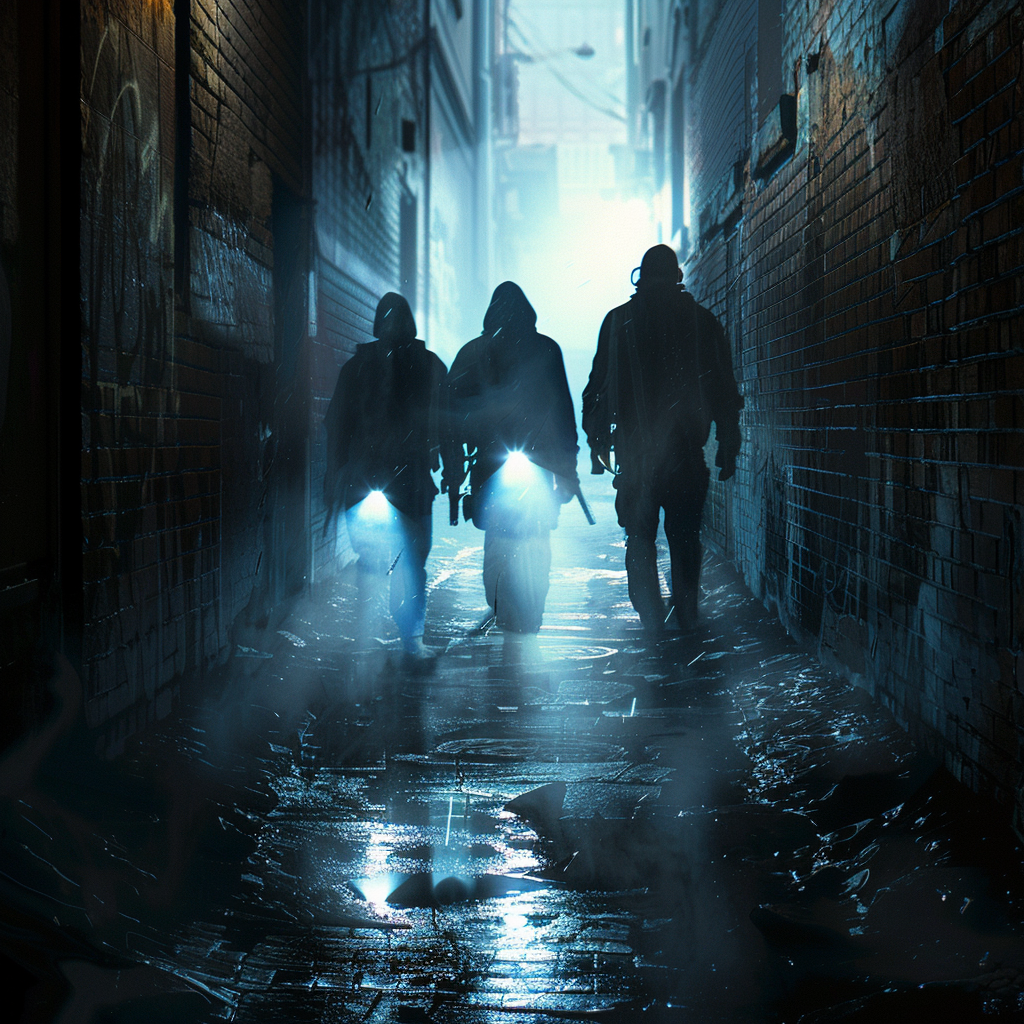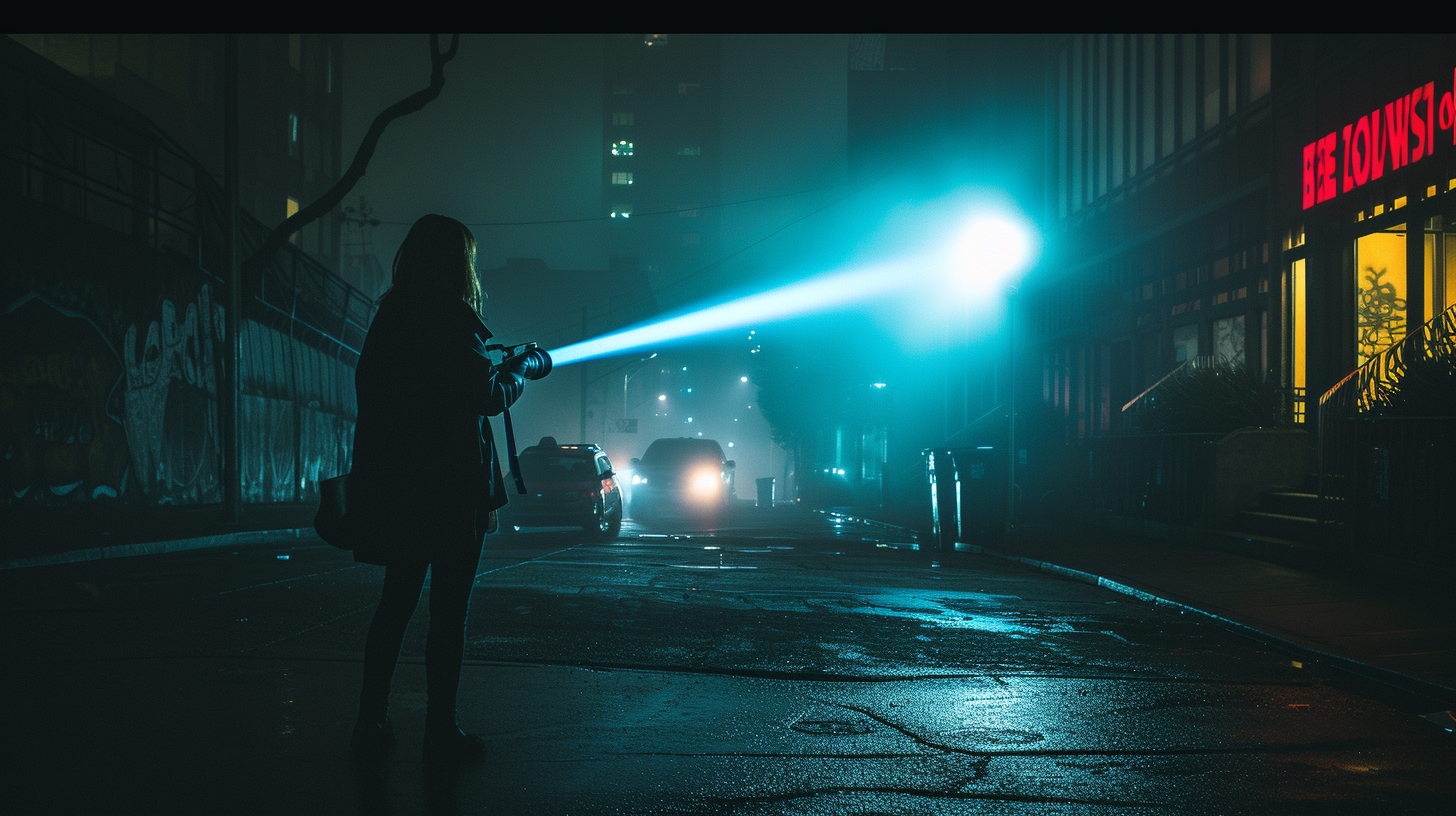What Is a Blue Lens on a Flashlight For?

You might wonder why some flashlights come equipped with a blue lens. It's not just for aesthetic appeal; a blue lens has practical applications that can be quite advantageous. For instance, it greatly improves night vision by preserving your eyes' natural adaptation to darkness, which is essential for activities like hunting or forensic work. Additionally, blue light penetrates fog better than other colors and enhances contrast when reading maps or charts. Furthermore, its applications span various fields, from medical uses to outdoor adventures. Curious to know more about its benefits?
Enhancing Night Vision
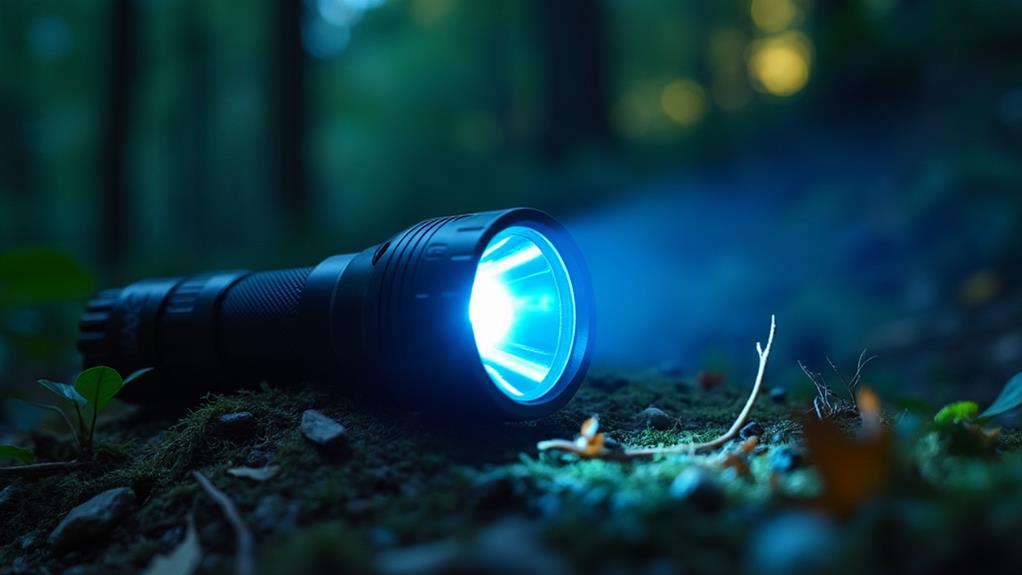
Blue lenses offer a distinct advantage in enhancing night vision by providing gentle illumination that preserves your natural night adaptation while highlighting essential details. In dark environments, blue light helps maintain your night vision, allowing you to see clearly without straining your eyes. This makes blue lenses particularly beneficial for tasks like reading maps and charts at night, as they minimize color distortion and ensure accurate information interpretation.
Additionally, blue lenses reduce glare, a significant benefit in low-light conditions. The softer light emitted by blue lenses is less likely to cause harsh reflections, making your surroundings easier to see. This reduction in glare also makes you less detectable by night vision devices, facilitating stealthier movement during tactical operations.
Moreover, blue light enables you to distinguish between different shades and details in low-light environments, a critical capability when identifying subtle differences without compromising your night vision. By incorporating blue lenses into your nighttime activities, you can see clearly and move confidently, regardless of the surrounding darkness.
Tracking Blood Trails
When tracking blood trails, using a blue lens on your flashlight can be highly effective. Blue light enhances blood visibility, allowing you to follow trails even in low-light conditions. Additionally, its wavelengths scatter less in fog and dust, reducing unwanted reflections and ensuring a clearer view.
Enhanced Blood Visibility
Hunters and investigators often face the challenge of tracking blood trails in low-light conditions, but blue lenses on flashlights significantly increase visibility. The specific wavelength of blue light (380-495 nm) makes blood trails stand out against surrounding surfaces, providing essential contrast for efficient tracking in both dense woods and urban environments.
Unlike white light, blue light does not reflect as much off surfaces, offering clearer visibility in challenging conditions such as fog or dust. This allows for easier tracking of blood trails without distractions from other environmental elements. Additionally, blue light is less likely to alert wildlife, as animals are generally less sensitive to this wavelength, enabling stealthier tracking of wounded animals.
For investigators, the enhanced visibility is crucial for locating blood evidence at crime scenes, aiding in more effective case resolution. Medical personnel also benefit from blue lenses, as the increased blood visibility can be critical in emergency situations, allowing for quick and accurate identification of blood in low-light conditions.
Low-Light Tracking Benefits
Blue lenses on flashlights offer significant advantages for low-light tracking, particularly in identifying blood trails. Whether you are hunting or participating in a search and rescue mission, the ability to clearly see blood can be crucial. Blue light enhances the visibility of blood trails, making it easier to track wounded animals or locate evidence in dim conditions. The specific wavelengths of blue light scatter less than other colors, providing clearer visibility against various backgrounds, especially in darkness.
Unlike red light, which can sometimes obscure or wash out blood, blue light creates a stark contrast, allowing you to follow the trail more effectively. This technology benefits not only hunters but also medics and first responders. In emergency situations, quickly identifying blood can facilitate faster decision-making and prompt actions. Additionally, the improved visibility of other bodily fluids makes blue lenses valuable in forensic applications.
Stealth and Night Vision
Utilizing a blue lens on your flashlight offers significant advantages for stealth and night vision, particularly when tracking blood trails. Blue light enhances the visibility of blood, making it easier to track wounded animals or identify evidence in low-light conditions. Its specific wavelength helps distinguish blood from the surrounding environment, providing clearer visibility without the reflective glare associated with white light.
Maintaining night vision is crucial in the field. Blue light preserves your night vision better than white light, allowing you to see in the dark while concentrating on the trail. This is especially beneficial in tactical operations where stealth is paramount. Blue light is less detectable by night vision devices, giving you an edge in staying concealed.
Additionally, blue light performs well in wet environments, penetrating water more effectively than other colors. This allows you to track in foggy or rainy conditions without disrupting aquatic life. Unlike red light, which can obscure details, blue light maintains the necessary contrast for detailed visibility. By using a blue lens on your flashlight, you enhance your ability to track blood trails efficiently and discreetly, ensuring successful and stealthy operations.
Navigating in Fog
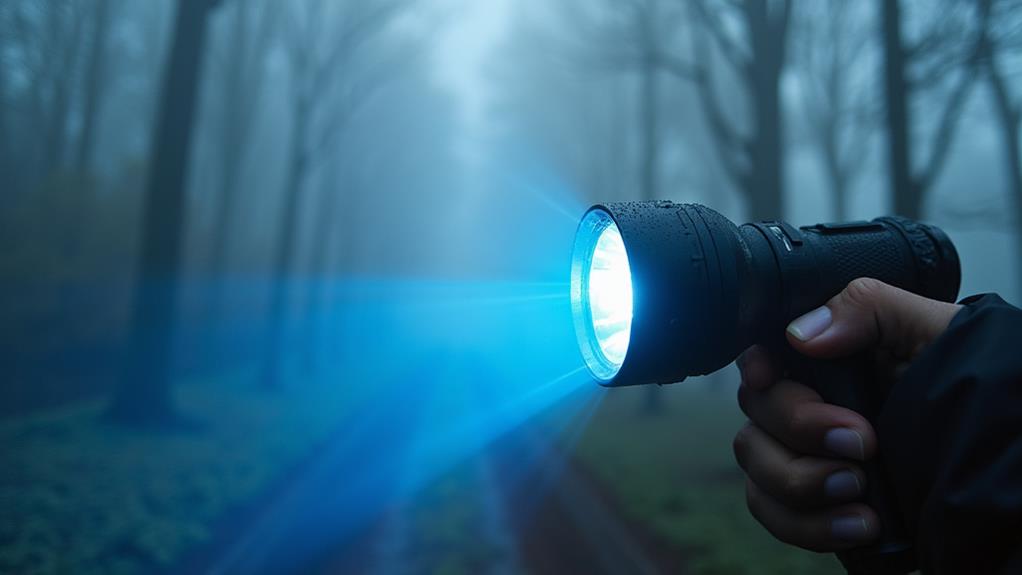
Navigating through fog can be challenging, but a flashlight with a blue lens can significantly enhance your visibility. Blue light, due to its shorter wavelengths, penetrates fog more effectively than white light. This improves clarity and range in low-visibility conditions by reducing reflection and glare, thus providing clearer sightlines and aiding in safe navigation.
Using a blue lens flashlight also helps avoid the halo effect, common with other light colors in foggy conditions, allowing you to see distant objects without straining your eyes. Additionally, blue light preserves your night vision, keeping your eyes adapted to the darkness and enhancing overall visibility.
Key benefits of a blue lens flashlight in fog include:
- Effective Fog Penetration: Shorter wavelengths of blue light cut through fog better than white light.
- Reduced Reflection and Glare: Blue light minimizes these issues, aiding clearer vision.
- Halo Effect Prevention: Helps in seeing distant objects without eye strain.
- Night Vision Preservation: Keeps your eyes adapted to the dark, enhancing general visibility.
Utilizing a blue lens on your flashlight can make navigating foggy conditions much safer and more manageable.
Reading Maps and Charts
Using a blue lens on your flashlight while navigating at night can significantly enhance map readability. It helps reveal map details clearly without causing color distortion, and it maintains your night vision by minimizing glare.
Enhanced Night Map Reading
Many find that using a blue lens on a flashlight significantly enhances night map reading. Blue light is particularly effective for this purpose because it boosts the contrast on printed materials, allowing detailed discernment without washing out colors. This is crucial for reading maps and charts that use different hues to convey information.
Using a blue lens offers several advantages:
- Reduces glare: Blue light minimizes glare, making it easier on your eyes when reading intricate details.
- Preserves night vision: The specific wavelength of blue light (380-495 nm) helps maintain night vision, enabling quicker adaptation back to darkness.
- Less detectable: Blue light is less likely to be picked up by night vision devices, providing discreet guidance in tactical situations.
- Better for printed materials: It minimizes color distortion on maps and charts, ensuring accurate information.
Additionally, many military and outdoor guidance tools come equipped with blue lighting features to optimize night-time map reading. This ensures you don't compromise your night vision while still being able to read maps clearly. So, the next time you're navigating in the dark, consider using a blue lens on your flashlight for a more effective and safer experience.
Color Distortion Reduction
Clear navigation is crucial, and utilizing a blue lens on a flashlight effectively addresses the issue of color distortion. When reading maps or nautical charts, seeing the original colors as intended is essential. Blue lenses reduce color distortion, ensuring accurate interpretation of printed material.
The wavelength of blue light is beneficial for enhancing the visibility of details on maps. It highlights fine lines and intricate features that might be obscured under other light colors. Unlike white or red light, blue light is less likely to interfere with color perception, preserving the accuracy of map symbols and hues.
Moreover, a blue lens can prevent glare and reflections, especially on glossy surfaces. This capability is invaluable in low-light conditions, allowing for greater clarity and ease in reading. Both military personnel and outdoor enthusiasts often use blue lenses for these reasons. They offer a balance between visibility and stealth, making them essential in tactical situations. By using blue light, you significantly reduce color distortion, ensuring your navigation remains precise and reliable.
Forensic Applications
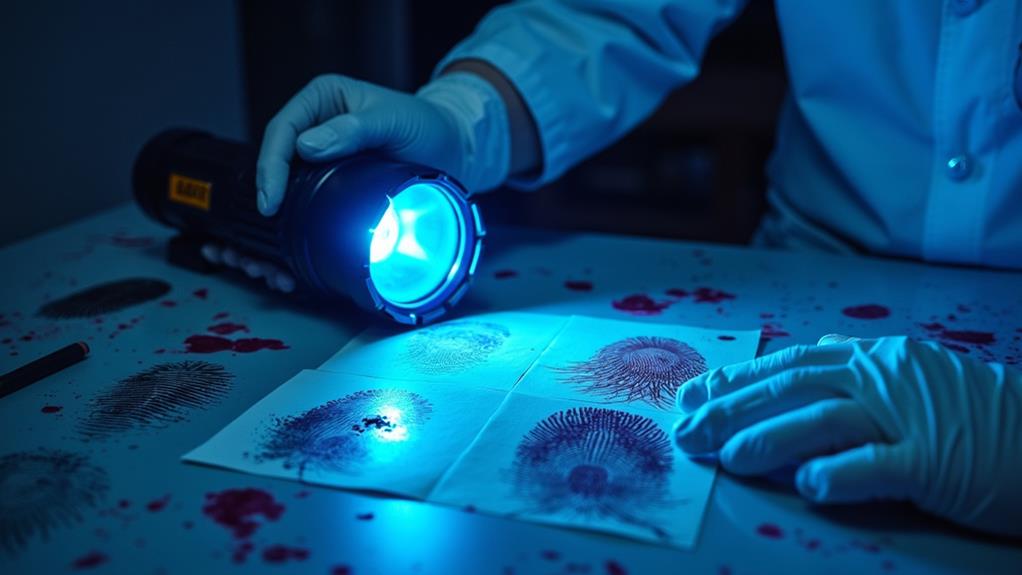
How can blue lenses on flashlights transform forensic investigations? Blue light significantly enhances forensic applications by making otherwise invisible evidence visible. For instance, blood and bodily fluids fluoresce under blue light, allowing for quick and accurate location and documentation of essential evidence.
Blue lenses offer several key advantages in forensic work:
- Improved Visibility: Blue light helps detect traces of substances that are invisible under regular lighting.
- Outdoor Efficiency: Its ability to penetrate fog and dust makes it ideal for gathering evidence in challenging environments.
- Contrast Enhancement: Blue light increases the visibility of hidden debris and improves contrast, aiding in evidence identification.
- Stealth Operations: Low visibility to night vision devices allows thorough investigations without alerting nearby individuals.
In the field, the unique properties of blue light can be a game-changer. Whether dealing with a crime scene in a foggy forest or a dusty warehouse, a blue lens on your flashlight ensures you won't miss critical clues. Incorporating blue light into your forensic toolkit elevates your ability to uncover the truth in any situation.
Hunting and Fishing
When you're out in the wild, a blue lens on your flashlight can be an essential tool for both hunting and fishing. For hunters, blue light enhances the visibility of blood trails, making it easier to track wounded game without disturbing the environment. Unlike red lights, which can sometimes obscure such trails, blue light provides superior clarity and precision.
In fishing, blue light helps illuminate the water without causing reflections, allowing you to see beneath the surface while minimizing disturbance to aquatic life. Red lights are less effective in achieving this. Blue light's ability to penetrate fog and dust makes it particularly valuable during night-time activities when visibility is low.
Additionally, blue lenses are less detectable by night vision devices, giving you a stealth advantage in natural settings. This discreet movement can be the difference between a successful hunt or fishing trip and an unsuccessful one. Furthermore, blue light aids in cleaning tasks by revealing hidden debris or biological traces, making it beneficial for post-activity cleanup.
| Scenario | Blue Light Advantage | Red Light Limitation |
|---|---|---|
| Hunting | Enhances visibility of blood trails | Can obscure trails |
| Night Fishing | Minimizes water reflection | Less effective at reducing reflections |
| Low Visibility | Penetrates fog and dust | Limited penetration in such conditions |
Incorporating a blue lens into your flashlight toolkit can significantly improve your hunting and fishing efficiency.
Medical Uses

In addition to their advantages in hunting and fishing, blue lenses on flashlights hold significant value in medical applications. When working as a medic in low-light situations, blue light can be crucial. It enhances the visibility of blood and bodily fluids, allowing for quick identification and tracking of blood trails during search and rescue operations. Blue light offers better contrast against different surfaces, making it easier to locate injuries and assess wounds efficiently.
Key medical uses for blue light include:
- Enhanced visibility of blood: Blue light makes bodily fluids more visible, aiding in emergency medical scenarios.
- Phototherapy treatment: Blue light is used to treat conditions like jaundice by breaking down excess bilirubin in the skin.
- Cleanliness and safety: It helps reveal hidden debris, assisting healthcare professionals in maintaining a sterile environment.
- Emergency response: Emergency responders use blue light flashlights to quickly assess injuries and locate wounds.
In clinical settings, blue light's applications extend beyond visibility. It is also significant for phototherapy, helping to treat jaundice by breaking down bilirubin in the skin. This makes blue lenses on flashlights a versatile and indispensable tool in various medical scenarios.
Eye Safety Considerations
Blue lenses on flashlights can enhance the visibility of blood trails and bodily fluids, but caution is essential due to potential eye health risks. Prolonged exposure to blue light can lead to eye fatigue and discomfort. To mitigate these effects, use blue lenses sparingly and take regular breaks to promote overall eye safety.
Blue light scatters easily in the atmosphere, potentially causing visual discomfort in foggy or dusty conditions. Using blue lenses strategically can improve clarity and reduce eye strain. Additionally, blue lenses are less detectable by night vision devices, offering a tactical advantage. However, be cautious of glare, which can impair visibility.
Follow these key points for optimal eye safety:
| Key Point | Eye Safety Consideration |
|---|---|
| Improved visibility | Use sparingly to avoid eye fatigue |
| Prolonged exposure | Take regular breaks |
| Atmospheric scatter | Use strategically in foggy or dusty conditions |
| Stealth advantage | Be mindful of potential glare |
| Regular breaks | Maintain long-term eye health |
Comparison With Other Colors

Comparing blue lenses on flashlights with other colored lenses reveals distinct advantages and limitations for each. Blue lenses enhance the visibility of blood and bodily fluids, making them invaluable for hunting and forensic applications. However, blue light can compromise night vision, unlike red light, which is designed to preserve it.
When choosing a flashlight lens color, consider these factors:
- Red light: Ideal for preserving night vision and reducing eye strain during prolonged use in the dark.
- Green lenses: Useful for close-range tasks and maintaining night vision but more visible to wildlife, making them less ideal for hunting.
- Amber lenses: Improve visibility in foggy or smoky conditions and reduce glare, though they don't reveal details as effectively in low-light situations.
- Blue light: Excels in tracking and identifying traces, especially in misty conditions, but can be less effective for general night vision.
Each color lens serves a unique purpose, and selecting the right one depends on your specific needs. Blue light is particularly effective for certain tasks, though it is important to understand its limitations compared to other colors.

